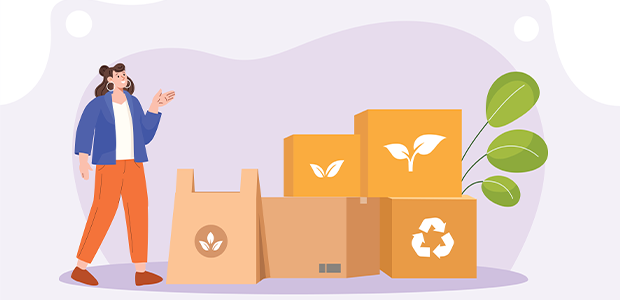
The benefits of sustainable packaging for your business
Sustainable packaging is becoming an increasingly important aspect of product design for any modern business. It involves using materials and methods that have a minimal impact on the environment, such as recyclable, biodegradable or renewable materials.
Consumers are increasingly looking for eco-friendly options, and businesses need to adapt to meet these expectations. By adopting sustainable packaging, companies can not only comply with regulations but also improve their brand image and operational efficiency. Sustainable packaging offers several benefits that make it a practical choice for businesses today.
Main benefits of sustainable packaging
Environmental benefits
Sustainable packaging helps to reduce waste and pollution. Traditional packaging often ends up in landfills and contributes to environmental problems. Sustainable packaging, however, is designed to be recyclable or biodegradable, which means it has a much lower impact on the environment. By using materials that can be reused or decomposed naturally, businesses can conserve natural resources and reduce their carbon footprint.
Economic advantages
Using sustainable packaging can lead to cost savings in various ways. Efficient use of materials can reduce waste and lower material costs. Additionally, sustainable packaging often results in reduced waste disposal costs since recyclable materials are typically cheaper to dispose of than non-recyclable ones. Over time, adopting sustainable practices can lead to increased efficiency and cost savings, which benefits many businesses financially.
Brand image and reputation
Adopting sustainable packaging can positively impact a company's brand image and reputation. Consumers are becoming more environmentally conscious and now prefer brands that demonstrate responsibility towards the environment. By using sustainable packaging, a business can enhance its public image, build trust with their customers, and differentiate itself from competitors. This can attract environmentally-conscious consumers, lead to increased customer loyalty and boost sales.
Regulatory compliance and risk management
With the rise in environmental regulations, businesses need to ensure they comply with current and future laws. Sustainable packaging can help companies stay ahead of these regulations, reducing the risk of fines and penalties. By proactively addressing environmental concerns, businesses can better manage risks associated with regulatory changes and avoid potential legal issues.
Innovation and market opportunities
Sustainable packaging encourages innovation and the development of new technologies. Businesses that invest in sustainable solutions can access new markets and customer segments that value eco-friendly products. This opens up opportunities for partnerships and collaborations with other companies and organisations focused on sustainability, leading to further market growth.
Operational efficiency
Sustainable packaging can improve operational efficiency by optimising the use of materials and reducing waste. Efficient packaging design can help businesses use space more effectively, and lower transportation and storage costs. This can streamline operations and result in cost savings throughout the supply chain. Sustainable practices can also lead to a more efficient and productive business overall.
Challenges and solutions
Initial costs and investment
One of the primary challenges of adopting sustainable packaging is the initial cost. Sustainable materials and processes can be more expensive upfront compared to traditional options. However, there are several ways to manage and mitigate these expenses:
- Gradual transition: businesses can gradually shift to sustainable packaging rather than making a complete switch all at once. This allows time to manage costs and adapt to new materials and processes
- Long-term savings: sustainability offers the potential for long-term savings due to reduced material usage, lower waste disposal costs, and improved efficiency. These savings can offset the higher initial investment over time
- Incentives and grants: explore available incentives, grants, and subsidies offered by governments or organisations that support sustainability initiatives. These can help reduce the financial burden of transitioning to sustainable packaging
Sourcing sustainable materials
Finding reliable suppliers of sustainable materials can be challenging. Businesses need to ensure a consistent supply of high-quality materials. To address this challenge:
- Research suppliers: conduct thorough research to identify reputable suppliers who offer certified sustainable materials. Building strong relationships with these suppliers can ensure a reliable and consistent supply
- Collaborate within your industry: collaborate with other businesses and industry groups to gain access to a broader network of sustainable material suppliers. Joint purchasing agreements can also help reduce costs and ensure a steady supply
- Source locally: consider sourcing materials locally to reduce transportation costs and environmental impact. Local suppliers can also provide more immediate and reliable delivery
Consumer education and engagement
Educating consumers about the benefits of sustainable packaging is crucial for its success. Without proper communication, customers may not understand the value of sustainable options. To effectively educate and engage consumers, use:
- Clear messaging: clear and concise messaging on packaging and marketing materials can help to explain the environmental benefits of your sustainable packaging. Highlight how it aligns with consumers' values and contributes to a healthier planet
- Marketing campaigns: develop marketing campaigns that focus on sustainability. Use social media, blogs, and other platforms to share stories and information about your sustainable packaging efforts
- Interactive engagement: encourage consumers to participate in sustainability efforts. This can include initiatives like recycling programs, incentives for returning packaging or social media discussions with customers about sustainability
By addressing these challenges with strategic solutions, businesses can successfully transition to sustainable packaging. This not only benefits the environment but also enhances brand reputation, operational efficiency, and long-term profitability.
For more startup news, check out the other articles on the website, and subscribe to the magazine for free. Listen to The Cereal Entrepreneur podcast for more interviews with entrepreneurs and big-hitters in the startup ecosystem.

